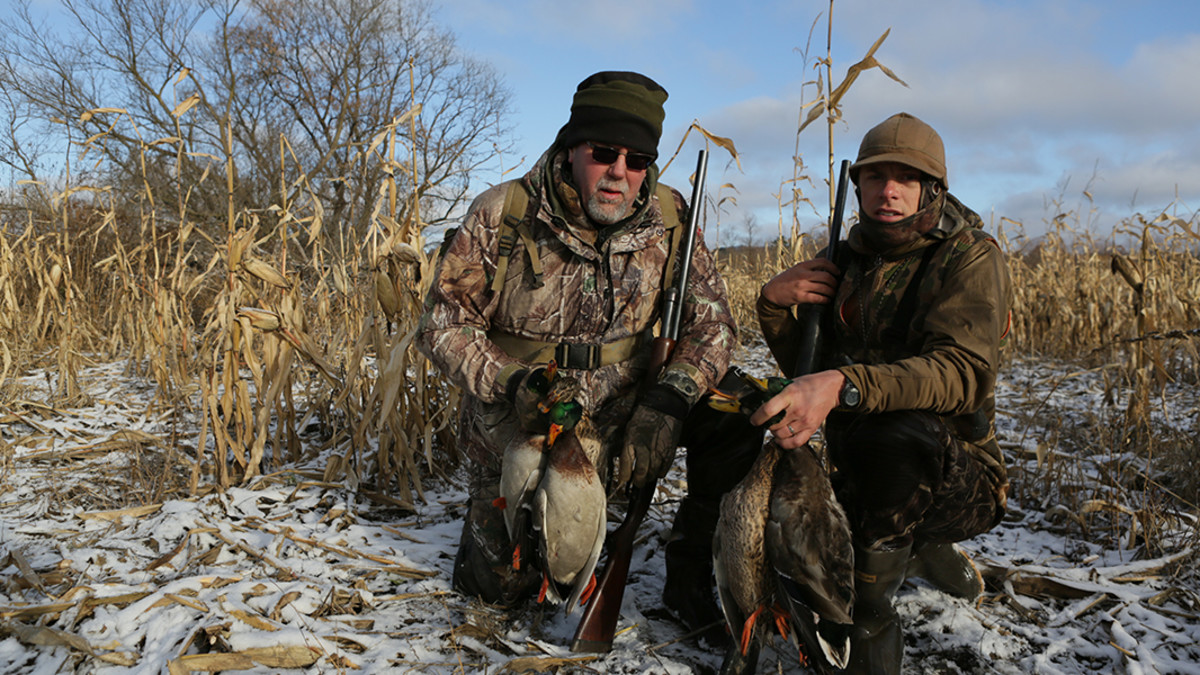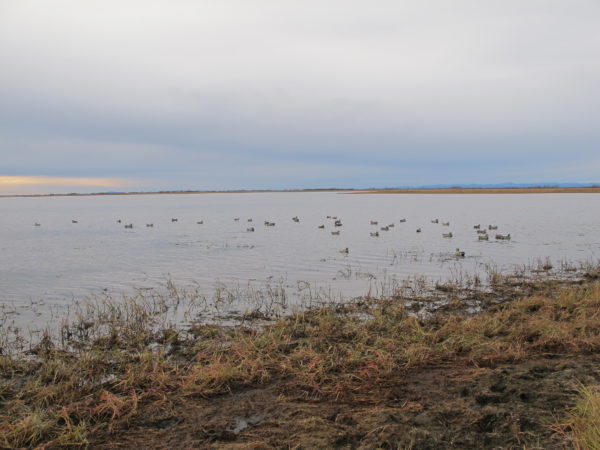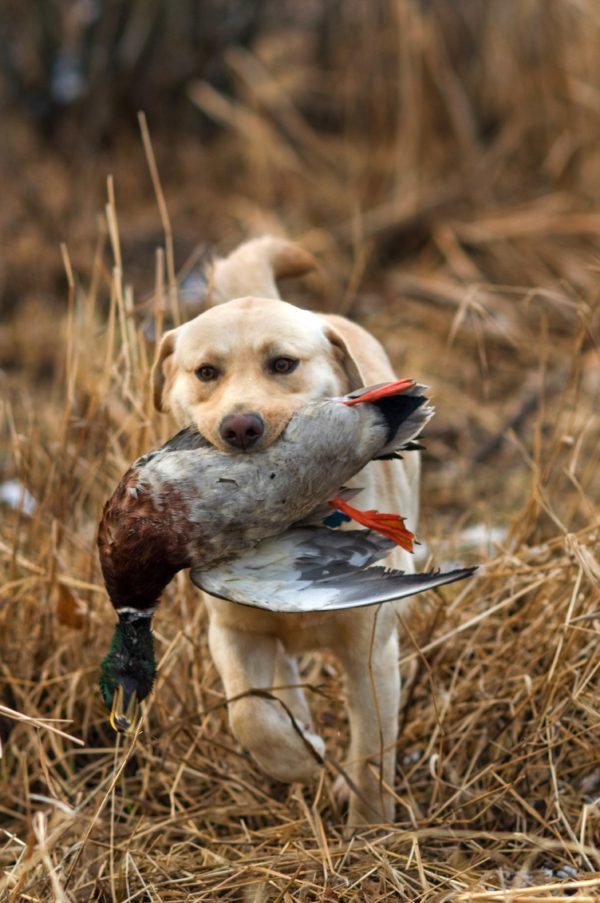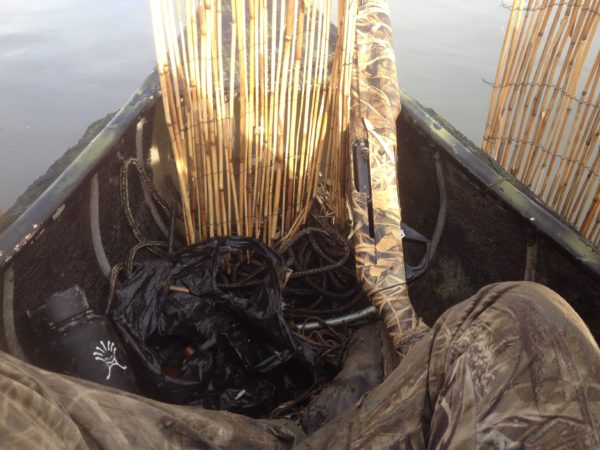
It’s difficult to list all the scenarios that one might encounter when hunting puddle ducks.
The birds use so many different habitat types in so many different ways that the possibilities are endless. In one week you could feasibly kill mallards on a bedroom-sized beaver pond, along a drainage ditch, in a cornfield, and on an island in the middle of a large lake without ever traveling more than a few miles from your home.
Scouting and flexibility are the keys to success. You need to scout to find out what the puddle ducks are doing, and you need to be flexible in order to exploit that information.
Decoying
The most thrilling way to hunt puddle ducks it to decoy them. The surest recipe for success is to set out your decoys right where you’ve seen ducks landing in the past few days, though this is hardly the only way to do it. Ducks are highly social critters, and they will readily abandon their day’s plan in order to investigate a new flock of “ducks” that you’ve positioned in a likely looking area.
Puddle ducks can be decoyed effectively all day, but early morning is perhaps the most optimal time. Ducks coming off their roosting area and heading toward an early morning feeding area will often commit to a spread of decoys much more readily than they will in the middle of the day when they’ve been shot at a time or two.
Roosting Water Hunts
Evening is a close second, especially when hunting roosting water. In general, the best duck hunting happens in the worst weather. Ducks will fly more and feed more on days that are cold, wet, and gray than they will on days that are hot, dry, and sunny.
When setting puddle duck decoys, don’t crowd the birds together. Puddle ducks feed in looser configurations than diver ducks. It’s common for hunters to leave as much as 10 feet of space between decoys. Keep the decoys facing into the wind, as that’s what real ducks generally do.
Puddle ducks are as wary as geese, so take camouflage very seriously. For hunting puddle ducks over decoys, use a 12-gauge shotgun loaded with 2 ¾” or 3” shells with 2, 3, or 4 shot. 2s and 3s for longer shots, 3s and 4s for closer shots. When exclusively targeting smaller puddle ducks like wood ducks and teal, an improved cylinder choke with 4 shot is a good bet.

Pass Shooting
While it might seem counterintuitive, the best locations for pass shooting ducks are those that receive the heaviest hunting pressure. Positioning yourself along a narrow channel between two lakes that get heavy hunting pressure allows you to capitalize on birds that will be getting bounced back and forth between hunters.
Another strategy is to locate a roosting area where ducks are congregating at night. In the predawn darkness, slip into position along the typical route that the birds fly when they lift off to visit their feeding areas. This is a quick and fairly effortless way to secure a duck for the dinner table before you head off to work. For pass-shooting ducks, use a 12-guage shotgun loaded with 3” shells with 2 or 3 shot.
Jump-Shooting
Jump-shooting works really well with puddle ducks thanks to their habit of feeding and loafing in shallow water close to shorelines. This is not the most challenging form of duck hunting, but it’s great when you’re hunting for food or teaching a youngster the fundamentals of hunting.
The method shares a lot in common with grouse and pheasant hunting, because you’re basically taking a quiet walk through likely habitats in hopes of flushing birds within shotgun range.
Wearing a pair of waders or hip boots, work the edges of narrow creeks, ponds, sloughs, or brushy lakeshores, or wade through marshes, swamps, or flooded timber. You’ll sometimes see ducks before they flush, or you’ll see ducks land in the distance. In this case, the hunt turns into a stalk as you try to sneak within range before they flush.
A lot of jump-shooting jaunts begin when you’re sitting in your blind on a slow day and you see a flock of docks land a couple hundred yards away. These side trips often reveal new locations where you’ll want to set decoys in the future.
If you’re lucky enough to see ducks in range before they flush, you can either jump the birds by shouting or you can shoot a bird off the water. If you do the latter, chamber a second round in a hurry because you’re almost sure to get a second shot as birds start to flush. When jump shooting, always be mindful of the surrounding cover. The ducks are flying away from you, and they’ll be even farther away when they land.

Don’t shoot birds over impenetrable cover where finding them will be too difficult to find unless you’ve got a good retrieving dog with a reliable nose. A variation on jump shooting is to team up with a buddy and use a canoe to float down rivers and streams. If you’re quiet, you’ll often drift right up on ducks before they flush.
When floating, use the contours of the shoreline to help conceal your approach. Ducks and geese will often lie at the lower end of islands and sandbars, so be ready when approaching these features. This can be an action-packed and highly productive way to hunt both ducks and geese.

When jump shooting ducks, use a 12-guage loaded with 2 ¾” or 3” shells. It’s a good idea to have a shell with #4 shot chambered and then have a pair of shells with #2 shot in the magazine. This makes you ready for a close shot as the birds flush followed by longer shots as the remainder of the birds hightail it away.




